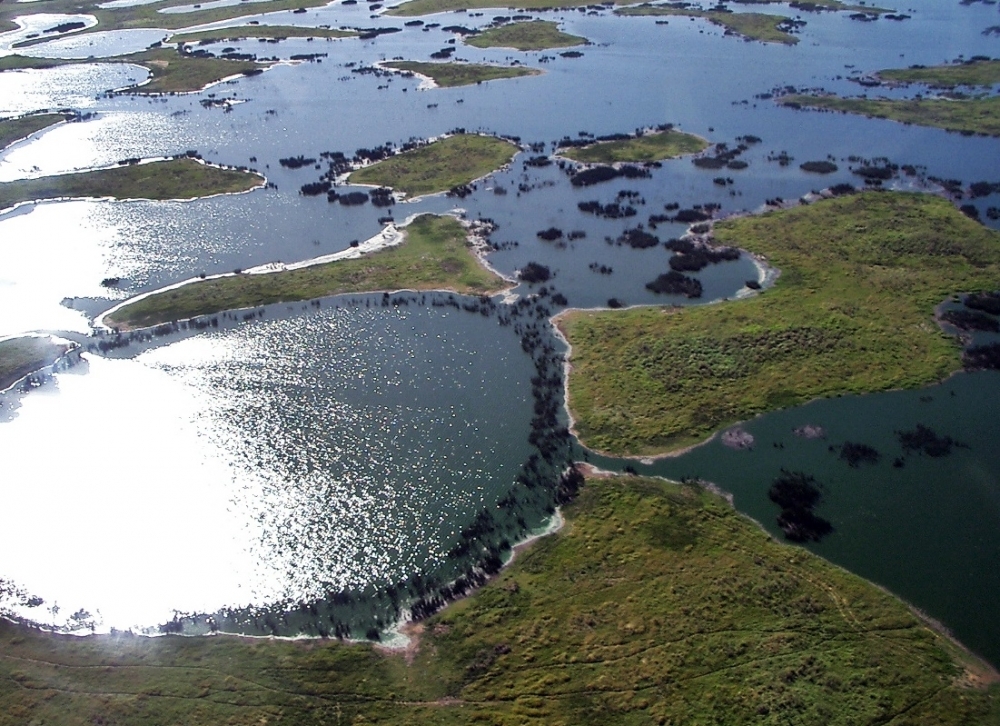

Models also suggest the region may see a 30%-40% decline in rainfall during the southern hemisphere's winter (photo: Wikimedia Commons)
Projections also suggest the amount of rainfall in the Pantanal could diminish by 30%-40% during the southern hemisphere's winter.
Projections also suggest the amount of rainfall in the Pantanal could diminish by 30%-40% during the southern hemisphere's winter.

Models also suggest the region may see a 30%-40% decline in rainfall during the southern hemisphere's winter (photo: Wikimedia Commons)
By Peter Moon | Agência FAPESP – Annual average temperatures in the Pantanal, the world’s largest floodplain wetland, could rise by up to 7°C by 2100. Warming on this scale would significantly reduce rainfall in the region, especially during the winter months. These effects of climate change combined would affect evaporation, and the very existence of the Pantanal as we know it would be threatened.
These and other projections using global climate models from the Fifth Assessment Report (AR5) issued in 2014 by the Intergovernmental Panel on Climate Change (IPCC) are part of a chapter on “Climate Change Scenarios in the Pantanal” in the book Dynamics of the Pantanal Wetland in South America.
The chapter’s lead author is José Antonio Marengo Orsini, a hydrologist and meteorologist at the Natural Disaster Surveillance & Early Warning Center (CEMADEN) in Cachoeira Paulista, São Paulo State, Brazil. The research is supported by FAPESP and the National Science & Technology Institute on Climate Change (INCT-MC), which in turn is supported by FAPESP and the National Council for Scientific & Technological Development (CNPq).
The Pantanal has a total area of 140,000 sq. km., 80% of which is in the Brazilian states of Mato Grosso do Sul and Mato Grosso. Its climate is semi-arid, and it would be a sandy thorn forest like the Northeast’s Caatinga if it were not for the enormous annual inflow of water, which makes the Pantanal a vast reservoir that stores the runoff from surrounding uplands.
During the rainy season (November-March), the riverbanks burst, and up to 70% of the floodplain is under water, forming shallow lakes, ponds, marshes, bogs and wooded swamps. Islands of vegetation stranded on higher ground serve as refuges for the abundant wildlife. Large areas remain flooded for between four and eight months every year, with water depths varying from a few centimeters to two meters.
During the dry season (April-September), the waters recede, the rivers return within their banks, and many of the lakes, ponds and marshes dry up. Water courses continue to flow through the basins of the Paraguay and Paraná Rivers toward the Plata and South Atlantic. They leave behind a layer of fertile sediment that boosts the growth of vegetation and pasture.
This is the Pantanal today. Annual rainfall levels range between 1,000 and 1,250 mm. Temperatures average 24°C during the year, with highs of approximately 41°C on some days. What do Marengo’s climate projections indicate for the future?
The IPCC’s Fifth Assessment Report projects a rise of 3.7°C-4.8°C in the global average temperature by 2100. When its parameters were used to analyze the Pantanal’s specific climate variables, the results were a shock. By 2040, average temperatures are expected to rise 2°C-3°C. They may rise 4°C-5°C by 2070 and 6°C by 2100.
Although there is a great deal of uncertainty about rainfall projections, the models suggest the amount of rain in the Pantanal could diminish by 30%-40% during the southern hemisphere’s winter.
Higher temperatures combined with less rainfall mean an increase in evaporation in the Pantanal. Depending on the temperature, considerable amounts of impounded water could disappear, reducing the total flooded area and the amount of water in the areas that remain flooded. “A rise of 5°C-6°C in the average temperature would cause a water deficiency, which would affect biodiversity and the human population,” Marengo said.
The consequences could be drastic for fauna and flora alike. Plant species that cannot adapt to reduced levels of humidity may disappear or migrate to other regions. Different plant species that prefer a drier climate would germinate in their place.
These changes in vegetation would directly affect the populations of invertebrates and herbivorous vertebrates – capybaras, tapirs and ranch cattle – in a chain reaction involving every niche in the food chain up to the top-tier predators, such as felines, alligators and birds of prey.
Marengo stressed that uncertainty about climate change is still an issue, especially with respect to rainfall. Even so, there can be no doubt that global temperatures are rising and that the Pantanal will not escape the effects.
Because the floodplain wetland making up the Pantanal is located in the heart of South America and hence far away from maritime influences that could help temper its climate, the rise in temperatures will tend to be more dramatic in the Pantanal. “The warmest day of the year could be as much as 10°C hotter than today,” Marengo said.
If the current temperatures in the Pantanal easily surpass 40°C on the warmest summer days, we can expect highs of approximately 50°C or more – desert temperatures. Most plants can tolerate such heat for a short time. Very short.
The article “Climate Change Scenarios in the Pantanal” by Jose A. Marengo et al., published in Dynamics of the Pantanal Wetland in South America by Springer International Publishing in Switzerland (doi: 10.1007/698_2015_357), can be read at http://link.springer.com/chapter/10.1007/698_2015_357.
Republish
The Agency FAPESP licenses news via Creative Commons (CC-BY-NC-ND) so that they can be republished free of charge and in a simple way by other digital or printed vehicles. Agência FAPESP must be credited as the source of the content being republished and the name of the reporter (if any) must be attributed. Using the HMTL button below allows compliance with these rules, detailed in Digital Republishing Policy FAPESP.




